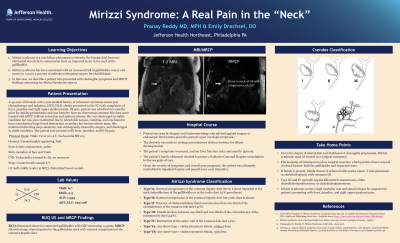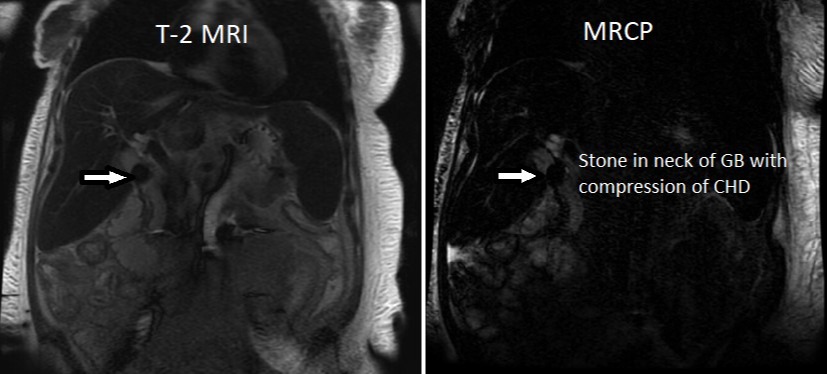Back


Poster Session A - Sunday Afternoon
Category: Biliary/Pancreas
A0046 - Mirizzi Syndrome: A Real Pain in the “neck”
Sunday, October 23, 2022
5:00 PM – 7:00 PM ET
Location: Crown Ballroom

Has Audio

Pranay Reddy, MD, MPH
Jefferson Health Northeast
Philadelphia, PA
Presenting Author(s)
Pranay Reddy, MD, MPH, Emily Drechsel, DO
Jefferson Health Northeast, Philadelphia, PA
Introduction: Mirizzi syndrome is a rare biliary phenomenon whereby the hepatic duct becomes obstructed via extrinsic compression from an impacted stone in the neck of the gallbladder. Mirizzi syndrome has been associated with an increased risk of gallbladder cancer and occurs in 0.05 to 4 percent of patients undergoing surgery for cholelithiasis. In this case, we describe a patient who presented with cholangitic symptoms and MRCP findings concerning for Mirizzi Syndrome type 1a.
Case Description/Methods: A 49-year-old female with a past medical history of colorectal carcinoma status post chemotherapy and radiation, HTN, HLD and obesity presented to the ED with complaints of fever, jaundice and right upper quadrant pain. Of note, patient was admitted two months prior for similar presentation and was found to have an obstructing common bile duct stone treated with ERCP, balloon extraction and sphincterotomy. She was discharged in stable condition but was soon readmitted due to intractable nausea, vomiting, and was found to have a mechanical large bowel obstruction secondary to known colonic mass. She underwent diverting loop colostomy, was subsequently cleared by surgery, and discharged in stable condition. The patient now presents with fever, jaundice, and RUQ pain. Physical exam revealed profoundly icteric conjunctiva, diffuse jaundice of face and trunk, diminished bowel sounds, and right upper quadrant abdominal tenderness. Labs were remarkable for TBili 6.7, DBili 5.3, ALP 1,553, and leukocytosis. RUQ ultrasound showed a contracted gallbladder with CBD measuring 14.5mm. MRCP showed a large stone impacted in the gallbladder neck with external compression of the common hepatic duct. Patient was seen by Surgery and Gastroenterology who advised against surgery or endoscopic intervention given the patient’s poor oncologic prognosis. The decision was made to undergo percutaneous cholecystostomy for biliary decompression. Given the severity of symptoms and overall poor prognosis, the patient was ultimately readmitted to inpatient hospice and passed away soon thereafter.
Discussion: Given the degree of obstruction and likelihood of cholangitis progression, Mirizzi syndrome must be treated as a surgical emergency. The mainstay of treatment involves surgical resection which permits direct removal of causal factors: both the gallbladder and impacted stone. Mirizzi syndrome carries a high mortality rate and should always be suspected in patients presenting with fever, jaundice, and right upper quadrant pain.

Disclosures:
Pranay Reddy, MD, MPH, Emily Drechsel, DO. A0046 - Mirizzi Syndrome: A Real Pain in the “neck”, ACG 2022 Annual Scientific Meeting Abstracts. Charlotte, NC: American College of Gastroenterology.
Jefferson Health Northeast, Philadelphia, PA
Introduction: Mirizzi syndrome is a rare biliary phenomenon whereby the hepatic duct becomes obstructed via extrinsic compression from an impacted stone in the neck of the gallbladder. Mirizzi syndrome has been associated with an increased risk of gallbladder cancer and occurs in 0.05 to 4 percent of patients undergoing surgery for cholelithiasis. In this case, we describe a patient who presented with cholangitic symptoms and MRCP findings concerning for Mirizzi Syndrome type 1a.
Case Description/Methods: A 49-year-old female with a past medical history of colorectal carcinoma status post chemotherapy and radiation, HTN, HLD and obesity presented to the ED with complaints of fever, jaundice and right upper quadrant pain. Of note, patient was admitted two months prior for similar presentation and was found to have an obstructing common bile duct stone treated with ERCP, balloon extraction and sphincterotomy. She was discharged in stable condition but was soon readmitted due to intractable nausea, vomiting, and was found to have a mechanical large bowel obstruction secondary to known colonic mass. She underwent diverting loop colostomy, was subsequently cleared by surgery, and discharged in stable condition. The patient now presents with fever, jaundice, and RUQ pain. Physical exam revealed profoundly icteric conjunctiva, diffuse jaundice of face and trunk, diminished bowel sounds, and right upper quadrant abdominal tenderness. Labs were remarkable for TBili 6.7, DBili 5.3, ALP 1,553, and leukocytosis. RUQ ultrasound showed a contracted gallbladder with CBD measuring 14.5mm. MRCP showed a large stone impacted in the gallbladder neck with external compression of the common hepatic duct. Patient was seen by Surgery and Gastroenterology who advised against surgery or endoscopic intervention given the patient’s poor oncologic prognosis. The decision was made to undergo percutaneous cholecystostomy for biliary decompression. Given the severity of symptoms and overall poor prognosis, the patient was ultimately readmitted to inpatient hospice and passed away soon thereafter.
Discussion: Given the degree of obstruction and likelihood of cholangitis progression, Mirizzi syndrome must be treated as a surgical emergency. The mainstay of treatment involves surgical resection which permits direct removal of causal factors: both the gallbladder and impacted stone. Mirizzi syndrome carries a high mortality rate and should always be suspected in patients presenting with fever, jaundice, and right upper quadrant pain.

Figure: MRI and MRCP showing stone in Gallbladder neck with compression of Common Hepatic Duct
Disclosures:
Pranay Reddy indicated no relevant financial relationships.
Emily Drechsel indicated no relevant financial relationships.
Pranay Reddy, MD, MPH, Emily Drechsel, DO. A0046 - Mirizzi Syndrome: A Real Pain in the “neck”, ACG 2022 Annual Scientific Meeting Abstracts. Charlotte, NC: American College of Gastroenterology.
